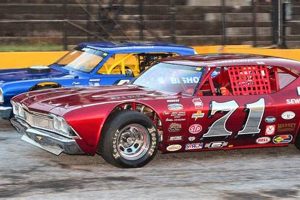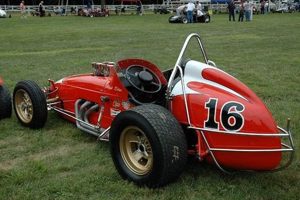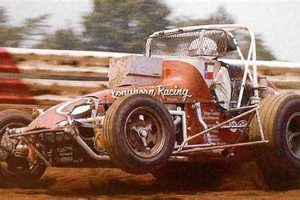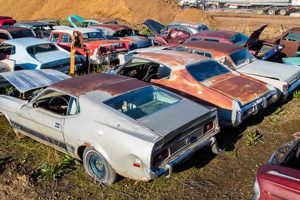The maintenance and restoration of automobiles manufactured in a bygone era represent a specialized field within automotive mechanics. This undertaking involves addressing the unique challenges presented by aged components, obsolete manufacturing techniques, and the scarcity of original parts. For example, a mechanic might meticulously rebuild a carburetor from a 1930s-era vehicle, sourcing replacement jets and floats to ensure proper fuel delivery.
Preserving these vehicles offers several advantages, encompassing the maintenance of cultural heritage, the appreciation of historical engineering, and the potential for significant investment returns. These machines represent tangible links to the past, showcasing design philosophies and manufacturing capabilities that differ greatly from contemporary approaches. Furthermore, restored examples can appreciate in value, particularly those with documented provenance or exceptional rarity. Owners contribute to a living history, preserving these vehicles for future generations.
Subsequent discussions will delve into specific aspects of this field, including locating and acquiring parts, selecting appropriate repair techniques, and understanding the specific needs of various makes and models. Detailed examination of common problems encountered during restoration, as well as the tools and skills required to perform these repairs, will be explored.
Essential Considerations for Restoring Classic Automobiles
Effective execution in this field requires careful planning and attention to detail. The following considerations are paramount to a successful project.
Tip 1: Comprehensive Assessment: Before commencing any work, a thorough evaluation of the vehicle’s condition is mandatory. This should encompass mechanical, structural, and cosmetic aspects, providing a clear understanding of the scope of work required. For example, a seemingly minor rust spot may indicate extensive corrosion beneath the surface.
Tip 2: Parts Sourcing Strategy: Locating original or appropriate replacement parts can be challenging. Establish a reliable network of suppliers, including specialized vendors, salvage yards, and online resources. Patience and diligence are essential in securing authentic components. For example, certain trim pieces may only be available through specialized auctions.
Tip 3: Documentation and Research: Thorough documentation of the vehicle’s history and specifications is crucial. Consult original factory manuals, technical bulletins, and owner’s literature to ensure accurate restoration. Understanding original assembly procedures will guide the restoration process. For example, torque specifications for engine components must adhere to original factory recommendations.
Tip 4: Employ Correct Techniques: Utilize repair methods appropriate for the vehicle’s age and construction. Avoid modern shortcuts that may compromise the vehicle’s originality or structural integrity. Welding techniques, for instance, may require adapting to the metallurgy of older steel alloys.
Tip 5: Preserving Originality: Strive to retain as much of the vehicle’s original fabric as possible. Refurbish original components whenever feasible, rather than replacing them outright. For example, original upholstery can often be restored, preserving the vehicle’s patina and character.
Tip 6: Professional Consultation: Seek advice from experienced specialists when encountering unfamiliar challenges. Consulting with experts in specific makes, models, or repair disciplines can prevent costly mistakes. For example, engaging a transmission specialist to overhaul a rare gearbox can ensure its proper function and longevity.
Tip 7: Budgetary Planning: Establish a realistic budget that accounts for potential unforeseen expenses. Restoration projects often exceed initial estimates, so contingency funds are prudent. For example, the discovery of hidden damage can significantly impact the cost of repairs.
Adhering to these guidelines will contribute significantly to the successful restoration, preserving a valuable piece of automotive history. A methodical approach and commitment to authenticity are paramount.
The subsequent section will address the long-term care and maintenance strategies necessary to preserve the integrity of restored automobiles.
1. Component Sourcing
Component sourcing constitutes a critical facet of classic automotive maintenance, directly influencing the feasibility, cost, and authenticity of restoration projects. The availability of original or period-correct replacement components determines the extent to which a vehicle can be returned to its factory specifications. Scarcity of parts, often a consequence of limited production runs or the attrition of aged materials, necessitates resourceful procurement strategies. For instance, the hydraulic brake system of a pre-war vehicle may require rebuilding using original cylinders and lines, obtainable only through specialized vendors or salvage operations. Failure to secure appropriate components can compromise the vehicle’s safety, performance, and historical value.
The process frequently involves a multi-pronged approach, encompassing the utilization of online marketplaces, participation in automotive swap meets, and engagement with specialized restoration shops. Each method presents its own challenges and benefits. Online marketplaces offer broad access but necessitate careful scrutiny to ensure authenticity and quality. Swap meets provide opportunities for direct inspection but may require extensive travel and negotiation. Restoration shops, while offering expert guidance, typically command higher prices. Successfully sourcing components often demands patience, persistence, and a thorough understanding of the vehicle’s original specifications. An example may be searching specialized antique automotive websites that sell obsolete parts, and comparing the component to the original that is being replaced, carefully noting any deviations from factory standards.
In conclusion, component sourcing is inextricably linked to the successful execution of classic automotive maintenance. The ability to identify, locate, and acquire appropriate parts directly impacts the completeness and historical accuracy of the restoration. Challenges in sourcing, while significant, can be overcome through diligent research, strategic networking, and a commitment to preserving the integrity of these historically significant machines. The implications extend beyond aesthetics, impacting the vehicle’s functionality, safety, and long-term value.
2. Authenticity Preservation
The pursuit of authenticity forms a cornerstone of effective maintenance strategies. Preserving a classic automobile’s original configuration, materials, and finishes is paramount to maintaining its historical significance and maximizing its value. Repairs deviating from factory specifications diminish the vehicle’s integrity, potentially impacting its collectability and its representation as a historical artifact. For instance, replacing original wiring harnesses with modern equivalents, while improving reliability, compromises the vehicle’s originality, affecting its value in concours competitions and among discerning collectors. Therefore, every repair decision requires careful consideration of its impact on authenticity.
Techniques employed in these preservation efforts span a broad spectrum, from meticulous cleaning and refurbishment of original components to the fabrication of replacement parts conforming to original specifications. The use of non-original fasteners, paint colors, or upholstery materials undermines the vehicle’s historical accuracy. Restoration professionals utilize factory manuals, technical drawings, and period photographs to ensure adherence to original manufacturing standards. Furthermore, experienced specialists possess in-depth knowledge of the specific nuances of particular makes and models, enabling them to identify and correct deviations from the original design. An example is the meticulous recreation of a cracked Bakelite dashboard knob, utilizing original molding techniques and materials to match the texture, color, and shape of the original component.
Ultimately, the commitment to authenticity in vintage car repair necessitates a blend of historical research, technical skill, and meticulous attention to detail. While practicality and safety concerns may necessitate certain deviations from originality, such alterations should be undertaken with full awareness of their potential impact. The long-term value and historical importance of these vehicles hinge on their accurate representation of the past; therefore, authenticity preservation remains a central tenet of responsible maintenance and restoration practices. The challenge lies in balancing the desire for functionality with the imperative to protect the vehicle’s heritage, requiring a delicate blend of technical expertise and historical sensitivity.
3. Specialized Tools
The effective execution of vintage car repair hinges significantly on the availability and proper utilization of specialized tools. Unlike modern vehicles, classic automobiles often feature unique designs, fasteners, and mechanical systems that necessitate tools not commonly found in contemporary automotive repair shops. These specialized implements enable mechanics to perform tasks with precision, minimize the risk of damage to delicate components, and maintain the authenticity of the restoration.
- Whitworth Wrenches and Sockets
Many British-made automobiles utilize Whitworth fasteners, a system distinct from both metric and SAE standards. Employing incorrect wrenches on these fasteners can result in rounding or damage, compromising their integrity and complicating future repairs. Whitworth wrenches and sockets, specifically designed for these unique dimensions, ensure proper engagement and torque application, preserving the fastener’s original condition. A real-world example would be attempting to remove a cylinder head bolt on a vintage Jaguar without the correct Whitworth socket, almost guaranteeing damage to the bolt head.
- Timing Lights and Compression Testers (Analog)
Early ignition systems and engine designs often require diagnostic tools that predate modern electronic equipment. Analog timing lights, specifically calibrated for older ignition systems, allow mechanics to accurately adjust timing without relying on digital interfaces incompatible with the vehicle’s technology. Similarly, analog compression testers provide accurate readings of cylinder pressure, assisting in the diagnosis of engine problems specific to older designs, such as worn piston rings or valve issues. For instance, diagnosing a misfire on a 1950s-era engine may require using an analog timing light to ensure proper ignition timing.
- Carburetor Synchronization Tools
Multi-carburetor setups, common in many classic sports cars and performance vehicles, require precise synchronization to ensure optimal engine performance and fuel economy. Specialized tools, such as vacuum gauges or flow meters, enable mechanics to balance the airflow through each carburetor, achieving smooth idling and consistent acceleration. Failing to properly synchronize carburetors can lead to rough running, poor fuel efficiency, and potential engine damage. An example of their application would be balancing the triple Weber carburetors on a classic Ferrari, requiring precise adjustments to ensure each cylinder receives the correct air-fuel mixture.
- Bodywork and Paint Tools (Original Style)
Restoring the bodywork and paint of vintage cars often requires specialized tools and techniques to replicate original finishes and repair damaged panels. Lead-based body fillers, common in older vehicles, necessitate specialized welding and shaping tools. Furthermore, matching original paint colors and application methods may require utilizing vintage spray guns and mixing techniques. Using modern bodywork techniques on a classic car can compromise its originality and diminish its value. For example, using lead body solder to repair a dent on a 1930s vehicle requires unique heating and shaping tools to achieve a seamless and authentic repair.
In conclusion, the utilization of specialized tools constitutes an indispensable element of successful vintage car repair. These tools not only facilitate accurate and efficient repairs but also contribute to the preservation of the vehicle’s originality and historical significance. The proper selection and application of these implements, combined with the knowledge and expertise of skilled mechanics, are essential for ensuring the longevity and integrity of these automotive treasures. The investment in specialized tools is an investment in the preservation of automotive history.
4. Historical Documentation
The accurate maintenance and restoration of vintage automobiles relies heavily on comprehensive historical documentation. These documents provide invaluable insights into original manufacturing specifications, assembly procedures, and material compositions, guiding the repair process and ensuring the preservation of authenticity. Access to reliable historical resources is, therefore, a critical determinant of the success and integrity of vintage car repair projects.
- Original Factory Manuals
These manuals, published by the vehicle manufacturer, contain detailed information regarding assembly diagrams, part numbers, and repair procedures. They serve as the definitive reference point for understanding the vehicle’s original design and construction. For example, an original factory manual for a 1930s-era vehicle might specify the correct torque settings for cylinder head bolts or the precise wiring diagram for the electrical system. Deviations from these specifications can compromise the vehicle’s reliability and historical accuracy.
- Technical Service Bulletins
Technical service bulletins (TSBs) were issued by manufacturers to address common problems or to provide updated repair procedures. These documents often contain critical information not found in the original factory manuals, such as revisions to component designs or recommended modifications to improve performance or reliability. For instance, a TSB might detail a revised carburetor jetting specification for a particular engine to address a known issue with fuel economy. Ignoring these bulletins can lead to misdiagnosis and incorrect repairs.
- Parts Catalogs
Parts catalogs provide detailed listings of original part numbers and descriptions, facilitating the identification and sourcing of appropriate replacement components. These catalogs often include exploded diagrams, illustrating the relationship between individual parts and their placement within the assembly. For example, a parts catalog might list the specific part number for a windshield wiper motor unique to a particular model year, aiding in the search for a correct replacement. Using incorrect parts can compromise the vehicle’s authenticity and functionality.
- Historical Photographs and Archives
Photographic archives and historical documentation, including period advertisements and owner’s manuals, offer valuable insights into the vehicle’s original appearance and features. These resources can assist in accurately replicating original paint colors, upholstery materials, and trim details. For example, a period photograph might reveal the correct placement of badges or the specific type of tires originally fitted to the vehicle. Relying solely on memory or anecdotal evidence can lead to inaccuracies and deviations from the original design.
The effective integration of these historical resources into the vintage car repair process is crucial for maintaining authenticity and ensuring long-term value. By consulting original factory manuals, technical service bulletins, parts catalogs, and historical photographs, mechanics can make informed decisions that respect the vehicle’s heritage and preserve its historical significance. Neglecting these resources can result in inaccurate repairs, diminished value, and a loss of the vehicle’s historical integrity. The commitment to thorough research is a cornerstone of responsible vintage car repair.
5. Craftsmanship Skills
The successful restoration and maintenance of classic automobiles are intrinsically linked to the application of highly specialized craftsmanship skills. The techniques required often diverge significantly from those employed in modern automotive repair, necessitating a deep understanding of historical manufacturing methods, materials, and tools. Without this skillset, the integrity and authenticity of vintage vehicles are at risk.
- Metal Fabrication and Welding
Vintage vehicles frequently require extensive metalwork to repair rust damage, accident damage, or fatigue-related cracking. Skilled metal fabricators are adept at shaping, welding, and finishing steel and aluminum panels using techniques that replicate original manufacturing processes. Examples include lead-based bodywork (common in pre-1950s vehicles) and gas welding techniques. Inadequate welding or metal forming can compromise structural integrity and detract from the vehicle’s historical accuracy.
- Engine Rebuilding and Tuning
Classic engines often feature designs and components that are no longer in common use. Rebuilding these engines requires a thorough understanding of their specific architecture, as well as the ability to diagnose and repair issues related to obsolete parts and manufacturing tolerances. Skilled engine builders are capable of machining components, fabricating replacement parts, and tuning engines to achieve optimal performance while maintaining originality. An instance includes rebuilding a flathead engine from the 1930s, requiring specialized knowledge of valve grinding and carburetor adjustment.
- Upholstery and Trim Restoration
The interior of a classic automobile contributes significantly to its overall value and authenticity. Upholstery and trim restoration requires skills in pattern making, sewing, leatherwork, and wood refinishing. Craftsmen specializing in this area are able to replicate original upholstery designs, repair damaged trim pieces, and source appropriate materials that match the vehicle’s original specifications. For example, re-covering seats with leather sourced from the same tannery as the original, or repairing a burled wood dashboard to its factory finish.
- Paint and Finishing
Achieving a historically accurate paint finish requires expertise in color matching, paint application techniques, and surface preparation. Skilled painters understand the nuances of original paint formulations and application methods, including the use of lacquer-based paints, hand-rubbed finishes, and multi-stage painting processes. They are also adept at repairing paint damage and blending new paint with existing finishes to achieve a seamless and authentic result. Correcting flaws in a vintage paint job or replicating a specific paint used when a car was first manufactured.
These craftsmanship skills, while distinct, are interconnected and essential for the comprehensive maintenance of vintage vehicles. The ability to seamlessly integrate these skills ensures the preservation of the vehicle’s historical integrity and enhances its long-term value. The dedication and expertise of skilled craftsmen are, therefore, indispensable to the ongoing preservation of automotive history. For example, a craftsman could repair a fuel pump from the 1940s, a project that depends on technical ability.
6. Preventative Maintenance
The longevity and preservation of vintage automobiles are directly correlated with the implementation of a robust preventative maintenance program. Due to the age and inherent design characteristics of these vehicles, proactive measures are crucial to mitigate the risk of component failure, minimize costly repairs, and maintain operational reliability. Unlike modern vehicles engineered for extended service intervals, classic automobiles typically require more frequent attention and specialized care. The consequences of neglecting preventative maintenance can range from minor inconveniences, such as a dead battery, to catastrophic engine or transmission failures, resulting in significant financial burdens and the potential loss of irreplaceable original parts. For instance, neglecting regular lubrication of chassis components can lead to accelerated wear and tear on suspension and steering systems, ultimately compromising the vehicle’s handling and safety. Furthermore, the deterioration of rubber components, such as hoses and seals, is accelerated by age and exposure to environmental factors, necessitating periodic inspection and replacement to prevent leaks and system malfunctions.
The scope of preventative maintenance for classic automobiles encompasses a wide array of tasks, including regular fluid changes (engine oil, coolant, brake fluid, transmission fluid), lubrication of chassis components, inspection and adjustment of ignition systems, monitoring of tire condition and pressure, and periodic cleaning and detailing to protect against corrosion. Moreover, specific attention must be paid to the unique needs of each vehicle, taking into account its make, model, year of manufacture, and operating conditions. For example, a vehicle equipped with a magneto ignition system requires periodic inspection and servicing of the magneto to ensure reliable spark delivery, while a vehicle with a carbureted engine may require periodic tuning to maintain optimal fuel-air mixture. Ignoring these specific requirements can lead to performance degradation, increased fuel consumption, and potential engine damage. Regular attention to cooling systems can prevent overheating, which can cause significant damage to an engine. Preventative actions include using appropriate coolant mixtures, checking the hoses and belts, and regular radiator flushing.
In conclusion, preventative maintenance constitutes an indispensable element of responsible ownership. By adhering to a comprehensive maintenance schedule and addressing potential issues proactively, owners can safeguard their investment, ensure the continued enjoyment of their vehicles, and preserve a valuable piece of automotive history. While the specific tasks involved may vary depending on the vehicle’s make and model, the underlying principle remains the same: diligent preventative maintenance is the key to preserving the integrity and longevity of classic automobiles, making it vital to this specialized branch of automotive care. The challenges include sourcing historically correct maintenance components. However, the practical significance of preventative maintenance is inarguably demonstrated by the sustained performance and prolonged lifespan of diligently maintained vehicles.
Frequently Asked Questions Regarding Vintage Car Repair
The following addresses common inquiries concerning the specialized field of vintage car repair. These questions aim to provide clarity and guidance for individuals seeking to maintain or restore historically significant automobiles.
Question 1: What constitutes a “vintage” automobile for repair purposes?
The classification of “vintage” is subjective, but generally encompasses vehicles manufactured prior to the widespread adoption of modern technologies such as electronic fuel injection and computerized engine management systems. Typically, vehicles produced before the 1980s are considered vintage for repair considerations.
Question 2: Are parts readily available for vintage car repair?
Parts availability varies significantly depending on the make, model, and year of the vehicle. Some components may be readily sourced from specialized vendors, while others require fabrication or salvage from donor vehicles. Component sourcing can be a significant undertaking requiring patience and persistence.
Question 3: What are the primary challenges associated with vintage car repair?
Challenges include the scarcity of parts, the lack of readily available technical information, the need for specialized tools and equipment, and the requirement for specific knowledge of historical manufacturing techniques. Addressing these challenges necessitates expertise and resourceful problem-solving.
Question 4: Can modern automotive repair shops effectively service vintage automobiles?
While some modern repair shops may possess the necessary skills and equipment, many lack the specific expertise required for vintage car repair. Seeking a specialist with proven experience in restoring and maintaining classic vehicles is highly recommended. Specialized technicians are better suited to address the unique challenges of vintage automobiles.
Question 5: Does vintage car repair typically cost more than repairing a modern vehicle?
In most cases, vintage car repair incurs higher costs due to the scarcity of parts, the specialized labor involved, and the potential need for custom fabrication. Owners should anticipate higher expenses compared to maintaining a contemporary automobile.
Question 6: What are the key considerations when selecting a vintage car repair specialist?
When selecting a repair specialist, consider their experience with the specific make and model of the vehicle, their access to parts and technical information, their reputation within the vintage car community, and their adherence to historically accurate repair techniques. Verifying credentials and seeking references are prudent steps.
Effective resolution of issues inherent in this specific automotive field requires specialized knowledge and a systematic strategy. The complexities associated with repairing vintage cars often demand a specific approach that includes considering parts availability and the costs.
The following section will discuss specific case studies in vintage car repair.
Conclusion
The preceding discussion has examined various facets of “vintage car repair,” encompassing sourcing components, preserving authenticity, utilizing specialized tools, leveraging historical documentation, employing skilled craftsmanship, and implementing preventative maintenance measures. These elements collectively define the scope and complexity of this specialized automotive field, underscoring the unique challenges inherent in preserving historically significant vehicles.
The enduring appeal of classic automobiles necessitates a continued commitment to the principles outlined herein. The preservation of automotive history requires diligence, expertise, and a profound appreciation for the craftsmanship of bygone eras. Future endeavors in this field should prioritize the dissemination of knowledge, the development of specialized skills, and the collaborative efforts essential for safeguarding these cultural artifacts for generations to come. The meticulous work ensures these vehicles remain a tangible connection to the past.







